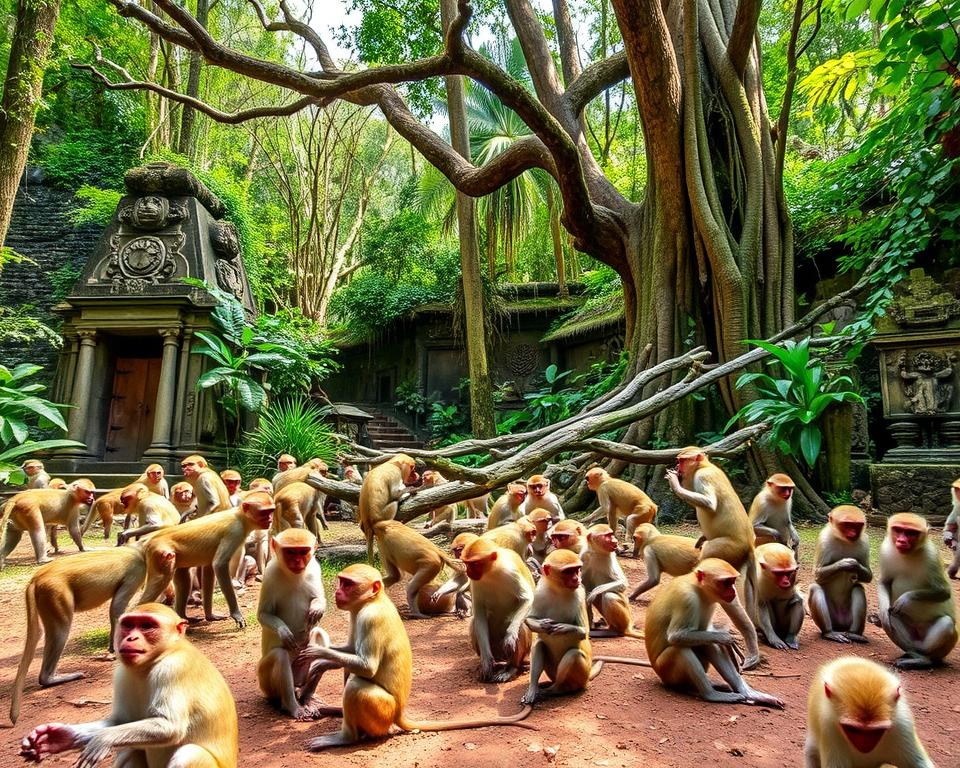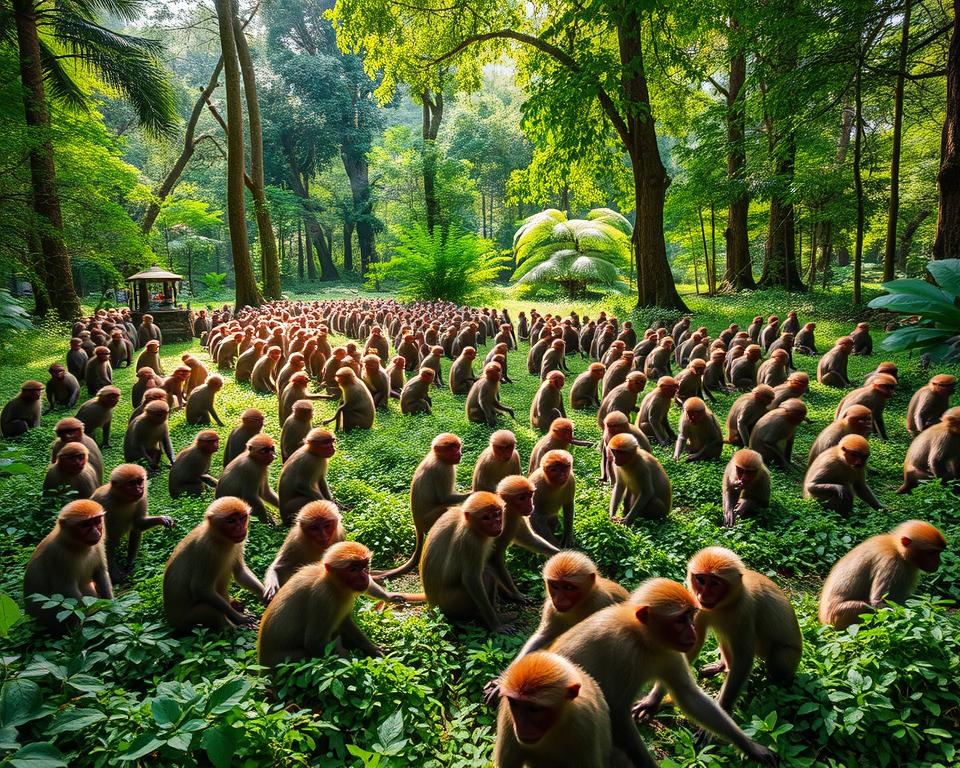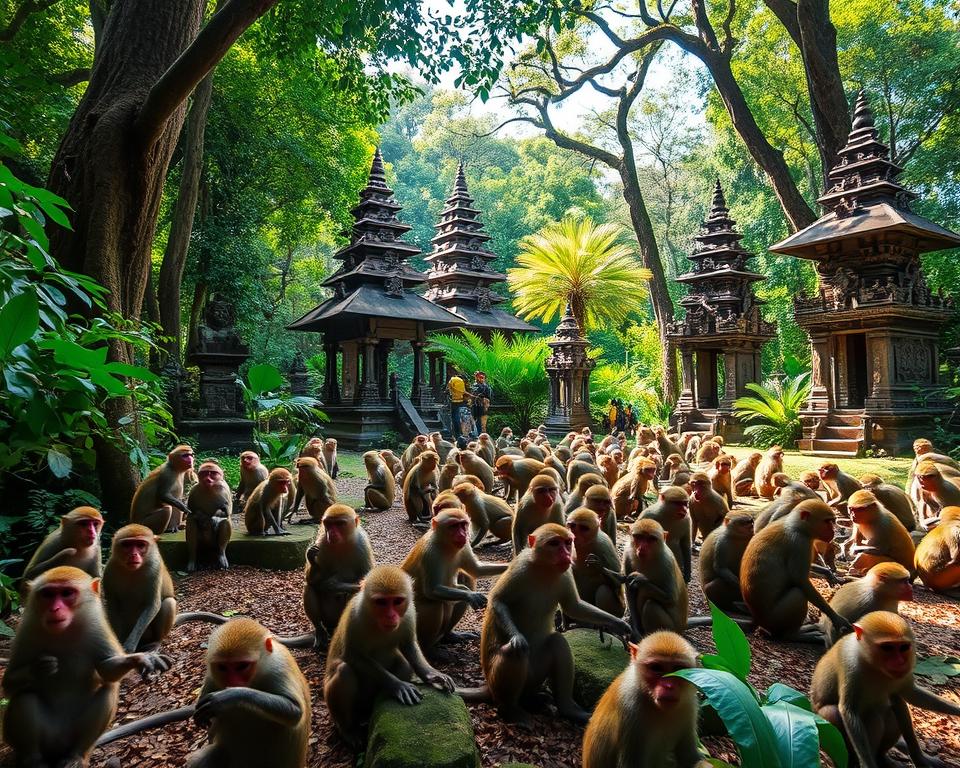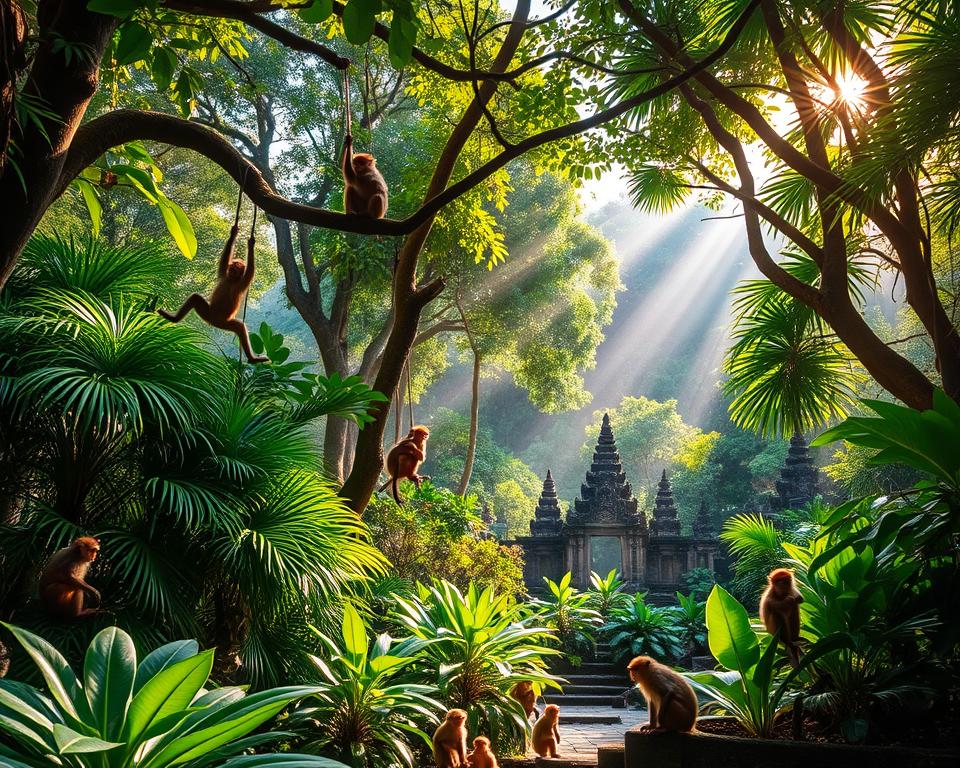
How many monkeys live in the Ubud Monkey Forest?
Ever wondered how many monkeys live in the Ubud Monkey Forest? It’s in the heart of Ubud, Bali. This place is loved by tourists and is also a key spot for conservation. It’s home to about 1260 Balinese long-tailed macaques, or crab-eating macaques.
These monkeys live in a 0.1 square kilometre dense forest. There are over 10 different groups. So, what does this mean for the local area and visitors1? Let’s find out more about the Ubud Monkey Forest population and their role in Balinese culture2.
Key Takeaways
- The Ubud Monkey Forest shelters around 1260 Balinese long-tailed macaques, divided into multiple social groups.
- Approximately 10,000–15,000 visitors come to see these monkeys each month.
- The sanctuary spans approximately 12.5 hectares, providing a rich habitat for diverse wildlife.
- Three times daily, the monkeys are fed with a primary diet of sweet potatoes.
- The monkey population’s growth must be managed to ensure both the animals’ and visitors’ safety.
Overview of the Ubud Monkey Forest
The Ubud Monkey Forest is a special nature reserve and spiritual site in Bali. It covers about 27 acres. This area is home to many plants and animals3.
Over 115 tree species live here, many of which are sacred in Balinese culture4.
There are about 340 long-tailed macaques in the forest. They live among the visitors and are a big part of the attraction3. The monkeys are divided into four groups, each with its own territory3.
Every month, over 10,000 people visit the Ubud Monkey Forest. It’s a very popular place in Bali3. Visitors enjoy watching the monkeys and exploring the local culture. They can find restaurants, shops, and places to stay nearby3.
The Ubud Monkey Forest is also important for research and conservation. Scientists study the monkeys’ behavior and social life. This helps us learn more about primates in their natural home4.
This place connects tourism with conservation. It teaches visitors about the importance of protecting nature.
The Ubud Monkey Forest is more than just a place to see animals. It’s also a spiritual and community treasure. It’s loved by both locals and tourists.
Population of Monkeys in the Sanctuary
The Ubud Monkey Forest is home to long-tailed macaques. They are known for being playful and curious. Their social structure is key to their lives, showing how they interact and share space.
Long-tailed Macaques Overview
Long-tailed macaques, or Macaca fascicularis, are common in Ubud. They are agile and smart, often seen playing with each other. The forest has over 115 tree species, making it perfect for them.
Current Population Numbers
There are over 600 monkeys in the forest, divided into four groups. This shows a healthy monkey population. However, there’s a growing number of monkey bites, so visitors need to be careful.
Each group has its own territory, adding to the monkeys’ complex social lives. Ticket sales help support local projects, like religious events and festivals567.

Understanding Long-tailed Macaques
Ubud’s simian residents, especially the long-tailed macaques, are key to the area’s biodiversity. About 340 of these monkeys live in the Sacred Monkey Forest. Their social structure is interesting to watch8. These monkeys adapt well to living near humans, in both natural and urban settings.
Long-tailed macaques live in groups of 100 to 120 members9. They have a complex social system, with adult males leading. Adult males can weigh almost 10 kg, showing their strength8. They are divided into age groups, helping us understand their growth.
During mating season, from May to August, they show unique behaviors. This attracts many visitors who love to see them. They eat a variety of foods, from sweet potatoes to fruits and leaves. Watching them interact with each other and humans is fascinating.
Scientists are studying these monkeys to learn more about them8. They look at their social structures, behaviors, and how tourism affects them. In Balinese Hinduism, these monkeys are seen as both protective and mischievous. This makes them special and protected in places like the Sacred Monkey Forest8.
Groups Within the Monkey Population
The Ubud Monkey Forest is home to many groups. These groups are key to how monkeys live together. They help keep the forest balanced and show how they survive.
Division of Groups in the Ubud Forest
In the sanctuary, there are ten groups of monkeys. These include the Temple Group and Central Group. Each group has its own area, leading to fights, especially when water is hard to find.
Knowing about these groups helps us understand the monkeys’ social lives. It shows how they deal with each other and their environment10.Learn more about their lives.

Ubud Monkey Forest Population Trends
The Ubud Monkey Forest has seen big changes in its monkey numbers over time. Things like environmental changes, food, and how people interact with them affect this. You might see how these changes make the monkeys act differently.
Historical Population Changes
Before COVID-19, about 3,000 tourists visited every day. This changed how the monkeys behaved and interacted. The constant presence of people made food more reliable, changing their natural ways.
Factors Affecting Population Dynamics
Visiting the forest, you’ll see how tourism impacts the monkeys. The environment also plays a big part. For example, changes in plants can affect food, which impacts the monkeys’ health and numbers.
The Balinese monkey census is key to tracking these changes. It helps make sure conservation efforts are effective11. For more on this amazing forest, check out this detailed overview of the Ubud Monkey Forest.
Visitor Influence on Monkey Behaviour
It’s important to know how visitors act in the Ubud Monkey Forest. Their actions can change how the monkeys behave. To keep the monkeys healthy, there are rules for how people can interact with them.
Feeding Practices and Guidelines
Feeding the monkeys is not allowed. This rule helps keep them from getting too fat and aggressive. It also keeps their natural behaviour intact.
In 1992, it was shown that teaching visitors is key to protecting the monkeys. This shows how education can help with tourism problems12.
Impact of Tourism on the Monkey Population
Tourism greatly affects the monkeys at the Ubud Monkey Forest. Many visitors lead to more aggressive behaviour, like biting. On average, there are three bites a day13.
Monkeys might also steal things from tourists. This shows how people’s actions change the monkeys’ behaviour. It’s good for both the tourists and the monkeys if people follow the rules.
Conservation Efforts at Ubud Monkey Forest
Conservation in Ubud is key to protecting the unique animals of the Ubud Monkey Forest. This sanctuary spans about 27 acres and is home to over 700 long-tailed macaques. It’s a big part of the area’s culture. The local foundation works hard to restore habitats, prevent diseases, and do research to keep the monkeys and the forest healthy14. Visitors can help by paying to enter, which supports conservation efforts15
Management of the Monkey Sanctuary
The sanctuary is split into six areas, each with its own group of monkeys. This helps keep their social life and health strong14. Visitors are asked to respect the animals and follow the rules to keep the forest calm for the macaques. The forest also has a special monkey hospital for sick animals15.
Studies on the monkeys’ behaviour, health, and environment help us understand their needs. They also teach people about responsible tourism. By visiting, people can learn about the forest’s history and beauty while helping with its conservation.
| Feature | Description |
|---|---|
| Size | Approximately 27 acres |
| Monkey Population | Over 700 long-tailed macaques |
| Tree Species | About 186 species |
| Groups | Divided into six territorial groups |
| Entrance Fee | IDR 80,000 for adults, IDR 60,000 for children |
| Operating Hours | Daily from 8:30 AM to 6:00 PM |
How many monkeys live in the Ubud Monkey Forest?
The Ubud Monkey Forest is home to over 1,200 long-tailed macaques. They live in groups across the area, which is as big as 31 football fields16. You might ask, how many monkeys are there? There are about 1,260 macaques here, making it a big place for these fun primates17.
This lively place supports not just the monkeys but also over 186 species of plants. It’s a home for many other animals too18. The mix of plants and animals makes it very important for nature.
The Ubud Monkey Forest welcomes over 10,000 visitors each month. They all want to see the monkeys in their natural home17. For just around 80,000 IDR for adults, it’s a great chance to see nature up close18. This money helps keep the monkeys and their home safe.

In short, the Ubud Monkey Forest is a vital place for the long-tailed macaques. It lets you see them up close and helps protect the local nature. This place is a big part of Ubud’s culture, showing how humans and animals live together.
The Importance of the Monkey Forest to Ubud
The Ubud Monkey Forest is very important for culture and learning. It shows the deep beliefs of the Balinese people. Visitors learn a lot about Balinese culture by exploring this place.
Cultural and Spiritual Significance
More than 700 Balinese monkeys live here. It’s also a sacred place since the 14th century. The Monkey Forest is key to Ubud’s spiritual heart194.
The temples and nature here are part of local traditions. They show the cultural significance of Ubud as a spiritual centre194.
Educational Opportunities for Visitors
The Monkey Forest is a natural classroom for everyone. It teaches about the monkeys and how to protect the environment. People from all over study the monkeys’ behaviour here204.
It teaches visitors about wildlife and how to save it. This way, the Monkey Forest helps people understand and love nature more.
Comparative Analysis with Other Monkey Sanctuaries
Exploring different monkey sanctuaries shows big differences in how they manage their populations. The Bali monkey sanctuary is a good example to compare with the Ubud Monkey Forest.
Bali Monkey Sanctuary Overview
The Bali monkey sanctuary is in a busy area. It has a special place for long-tailed macaques. It helps visitors learn and care for the monkeys, boosting tourism.
Population Comparisons
The Ubud Monkey Forest has about 600 macaques. This number helps shape their social lives and behaviors21. Other sanctuaries might have fewer monkeys, changing how they manage and care for them.
Studies at Ubud found 275 injuries and deaths from 2015 to 2018. Males get hurt more, while females die more often22. Local people’s views also matter, helping or hurting the monkeys’ lives in tourism23.
| Sanctuary | Population Size | Injury/Mortality Studies | Community Engagement |
|---|---|---|---|
| Ubud Monkey Forest | ~600 | 275 cases with varying outcomes | Positive attitudes from locals |
| Bali Monkey Sanctuary | ~300 (approx.) | Limited studies available | Varied perspectives on welfare |
Conclusion
The Ubud Monkey Forest is a special place for long-tailed macaques and many other animals. It has over 600 macaques living in different groups. Keeping their home balanced needs a lot of work and knowing how they live and what they mean to people2425.
It’s important to teach people how to help protect these monkeys. This is especially true since many visitors come to see the monkeys and the forest’s beauty.
The forest has more than 114 types of trees and three old Hindu temples. This makes it even more special and teaches visitors a lot24. But, more people coming can cause problems. Like fights between monkeys and the risk of rabies from touching animals24.
By learning about these problems and helping to solve them, you can help save this special place. This way, future generations can also enjoy it.
Visiting the Ubud Monkey Forest can be both fun and educational. But, it’s very important to follow the rules to keep the monkeys and visitors safe25. If everyone works together, the forest can stay a place where nature and culture live together. This will help the animals thrive and give visitors a great experience2425.
FAQ
How many monkeys live in the Ubud Monkey Forest?
The Ubud Monkey Forest is home to about 1260 long-tailed macaques. They are also known as crab-eating macaques.
What is the primary species found in the Ubud Monkey Forest?
The main species in the sanctuary is the long-tailed macaque. They are known for being social and smart.
How is the monkey population structured in the Ubud Monkey Forest?
The monkeys live in groups. Each group has its own territory. This leads to complex social interactions.
What factors influence the monkey population in the Ubud Monkey Forest?
Several things affect the population. These include changes in the environment, food availability, and human interaction from tourism.
Are visitors allowed to feed the monkeys in the Ubud Monkey Forest?
No, visitors can’t feed the monkeys anything but the food given by the staff. This is to keep the monkeys healthy.
What conservation efforts are in place at the Ubud Monkey Forest?
There are many efforts to protect the forest. These include managing the habitat, doing research, and working with the community. The goal is to keep biodiversity alive.
What is the significance of the Ubud Monkey Forest to the local culture?
The forest is very important to the local culture. It represents key parts of Balinese Hindu beliefs and practices.
How does the Ubud Monkey Forest compare with other sanctuaries in Bali?
The Ubud Monkey Forest has more monkeys than the Bali Monkey Sanctuary. It also has a more complex social structure among its monkeys.
Source Links
- Ubud Monkey Forest – https://en.wikipedia.org/wiki/Ubud_Monkey_Forest
- Ultimate Guide To The Sacred Monkey Forest Sanctuary In Ubud – https://finnsbeachclub.com/guides/monkey-forest-ubud/
- Ubud Monkey Forest – Indonesia Travel – https://www.indonesia.travel/au/en/destinations/bali-nusa-tenggara/ubud/ubud-monkey-forest.html
- History, Mission & Conservation | About | Monkey Forest Ubud – https://monkeyforestubud.com/about-us/
- 7 Facts About Ubud’s Monkey Forest – https://blog.komaneka.com/7-facts-about-ubuds-monkey-forest/
- Getting Attacked By Monkeys In Monkey Forest Ubud, Bali – https://nerdnomads.com/monkey-forest-ubud-bali
- Ubud Monkey Forest: All You Need to Know for 2024 Visit – https://balicheapesttours.com/ubud-monkey-forest.html
- Monkey Forest Ubud Information – https://individualbali.com/tourist-attractions/monkey-forest-ubud/
- Balinese Monkey Forest – why monkeys are sweet only when you keep the distance? | Travel and Keep Fit by Alex Jaskolowska – https://travelandkeepfit.com/en/2016/01/08/balinese-monkey-forest-why-monkeys-are-sweet-only-when-you-keep-the-distance/
- Explore the Sacred Monkey Forest Ubud in Bali, Indonesia – https://villaamrita.com/monkey-forest-ubud-in-bali/
- PDF – https://www.chrie.org/assets/docs/JHTC-case-notes/JHTC-vol-7/JHTC_Vol7Issue3-Bragg_case.pdf
- The effects of tourism on conservation at the monkey forst in Ubud, Bali – https://hal.science/hal-03528997/document
- The Monkey Forest Our Terrifying Experience at Ubud Monkey Forest – https://ourbigfattraveladventure.com/2013/07/03/terror-in-the-monkey-forest/
- Primates, Nature and Culture : Ubud Monkey Forest – Woods Bali – https://woodsbali.com/blog/primates-nature-and-culture-ubud-monkey-forest/
- Monkey Business: A Visit to Ubud’s Famous Sanctuary – https://www.ramblynjazz.com/post/monkey-business-a-visit-to-ubud-s-famous-sanctuary
- 10 Things to Know BEFORE Visiting the Ubud Monkey Forest – Destinationless Travel – https://destinationlesstravel.com/ubud-monkey-forest-bali/
- Monkeys in Bali: 5 places that are safe & ethical – https://www.sunshineseeker.com/destinations/monkeys-in-bali/
- What to Know Before You Visit the Monkey Forest in Ubud – https://theadventuremanual.com/monkey-forest-ubud/
- Going to Ubud Monkey Forest? What you should know! – https://www.alfredinbali.com/ubud-monkey-forest-1/
- Ubud Monkey Forest – 20 Things to Know Before You Go – https://bismacottagesubud.com/blog/ubud-monkey-forest-20-things-to-know-before-you-go/
- PDF – https://www.animalbehaviorandcognition.org/uploads/journals/17/AB&C_2017_Vol4(4)_Pelletier_et_al.pdf
- Healing Hanuman’s Army: Veterinary Care as a Core Component of One Health Principles in a Southeast Asian Monkey Forest – https://www.ncbi.nlm.nih.gov/pmc/articles/PMC10777948/
- PDF – https://edepot.wur.nl/506895
- Spectacular Monkey Forest Ubud: How to Enjoy and Stay Safe – https://www.travelphotographyguru.com/travel-blogs/sacred-monkey-forest-sanctuary
- ▷ Monkey Forest in Ubud – Sacred Monkey Forest | Bali.info – https://www.bali.info/en/monkey-forest-in-ubud-sacred-monkey-forest/